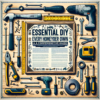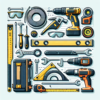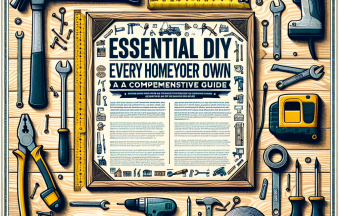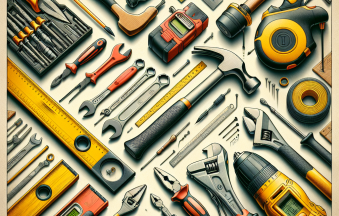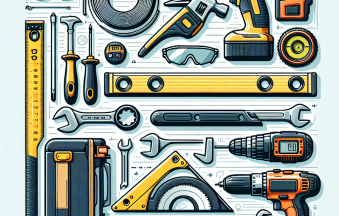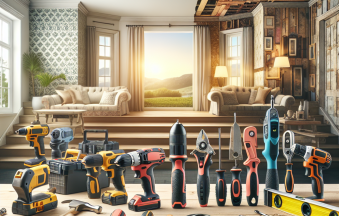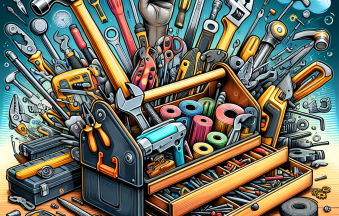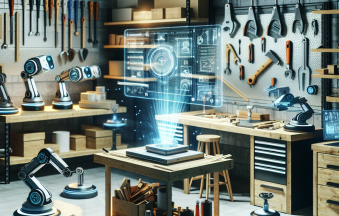Whether you’re a seasoned craftsman or just beginning your journey with home enhancement tasks, possessing the appropriate DIY tools can significantly impact your success. From household apparatus and construction materials to electrical devices and measuring tools, we will examine various classifications of DIY tools that can prepare you for any endeavor. Let’s explore each category to uncover the essentials you need to approach those tasks with assurance!
Home Tools
In the realm of DIY home upgrades, a robust assortment of home tools is essential. Consider implements such as saws, hammers, and drills. A cordless drill is indispensable for every homeowner; it assists not only with drilling holes but also excels at driving screws. Get a dependable circular saw for effortlessly cutting wood and other materials. Furthermore, a solid wooden workbench offers a stable platform for your endeavors, and don’t overlook storage solutions like toolboxes or pegboards to maintain order!
Construction Materials
No DIY task can be finalized without the appropriate construction materials. Equipping your workshop with items such as plywood, drywall, and insulation is vital for home improvements. Think about keeping a range of lumber sizes available for various jobs. If you intend to undertake a larger project, renting a table saw or having access to a nearby hardware store can greatly facilitate the cutting and measuring of lumber.
Electrical Equipment
Electrical tasks often fall to the DIY aficionado, but safety must always be a priority. Make sure you have the necessary electrical equipment like a voltage tester and a high-quality wire stripper. These tools will assist you in managing fundamental electrical tasks, such as setting up outlets or light fixtures, without jeopardizing your safety. For more extensive assignments, contemplate investing in a multimeter to measure electrical currents and verify that everything is operating correctly.
Common Electrical Inquiries:
- What precautions should I take when working with electricity? Always deactivate the circuit breaker before initiating any electrical work and employ insulated tools for safety.
Components & Fixings
Every DIY enthusiast requires a dependable assortment of components and fixings. Screws, nails, and anchors are available in a variety of sizes and styles, so having a basic inventory ready is essential. Consider a fixing kit to streamline your project preparation. A power screwdriver can also expedite the process when installing numerous screws. Ensure you understand the appropriate types of fixings for indoor versus outdoor projects; using the incorrect type can result in complications later!
Kitchen & Bathroom Tools
Updating your kitchen or bathroom can provide an excellent return on investment, and having the right DIY tools can enhance the experience. A plumber’s wrench is crucial for any plumbing tasks, whether you’re repairing a dripping faucet or shutting off water supply lines. Additionally, invest in a quality tile cutter if you intend to install a new backsplash or flooring. Don’t forget to acquire caulking guns and silicone caulk for sealing seams and protecting against water damage.
Light Bulbs & LEDs
Transitioning to LED light bulbs can not only conserve energy but also foster a welcoming ambiance in your home. When embarking on lighting tasks, ensure you have various types and wattages of bulbs to fit your fixtures. It’s also beneficial to familiarize yourself with color temperatures—warm, cool, and daylight—to make your spaces more inviting.
Lighting & Fans
Lighting and ceiling fans are integral to a home’s atmosphere. When installing lighting fittings or ceiling fans, the right tools are critical. A step ladder, for instance, will enable you to reach elevated areas safely. You may also require electrical tape and basic hand tools such as pliers and screwdrivers for the installation. Experimenting with dimmer switches can also add a fantastic touch to the atmosphere in your living spaces.
Measuring Instruments
Every DIY endeavor requires accurate measurements, which is why measuring instruments are crucial. A good tape measure and a quality level tool will guarantee precision when hanging shelves or installing cabinets. For larger projects, consider a laser level to provide a straight line over distances. Keep a notepad nearby to record measurements before commencing, as this can prevent costly errors.
Painting & Wall Materials
Lastly, don’t underestimate the importance of painting and wall materials when refreshing a room. Select high-quality paintbrushes and rollers to achieve a smooth finish. If you’re planning to paint a space, invest in painter’s tape for clean edges and sponges for touch-ups. If you’re feeling bold, faux finishes and textures can add character to your walls! Remember, lighter shades can make a room feel more spacious, while deeper hues can create a cozy atmosphere.
Equipped with the appropriate DIY tools from these categories will empower you to tackle projects with ease and creativity. As you gather your tools, keep in mind: preparation is half the battle, and the right equipment will not only assist you in completing the task but also enable you to relish the journey of transforming your space.





